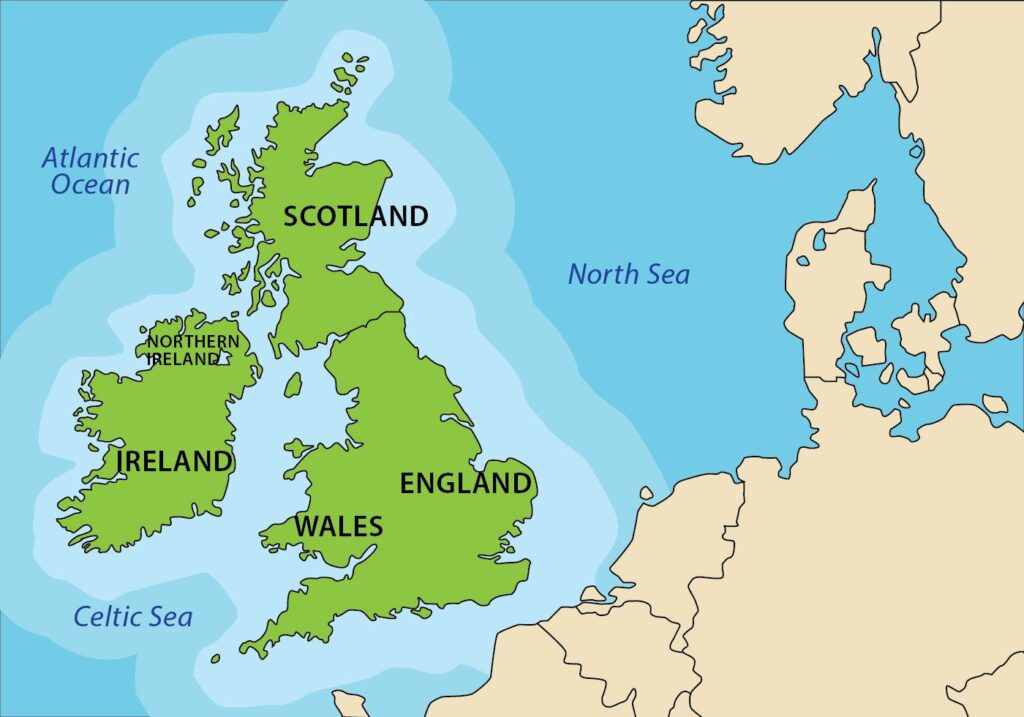Many people around the world find the names England, Great Britain and the UK as somehow confusing in as far as their applicability in day-to-day conversations is concerned. They are often used interchangeably to refer to one another. Part of the confusion could probably be coming from the fact that much of the United Kingdom is located on a single island that is itself a part of a larger set of islands. Read this article, to have a clear understanding and settle the confusion.
What is the British Isles?
The British Isles is a collective term used for Great Britain, Ireland and over 6000 smaller islands which surrounds them. This includes:
- The Isle of Wight (England)
- The Isle of Man
- Anglesea (Wales)
- The Shetland Islands (Scotland)
- The Outer Hebrides (Scotland)
- The Orkney Islands (Scotland)
- The Channel Islands
- The Aran Islands (Ireland)
- Clare Island (Ireland)
- Achill Island (Ireland)
The British Isles is a rarely used term but can be used to describe all the Islands and countries that sit within English, Welsh, Scottish and Irish sovereignty.

Great Britain
The island of Great Britain, also called “Albion” by the Romans, consists of three somewhat autonomous regions that include England, Scotland and Wales. It is located east of Ireland and northwest of France in the Atlantic Ocean. The term also includes several offshore islands, including the Hebrides in Scotland.
England
England is a country that is part of the United Kingdom. England is the largest both by landmass and population, and has taken a pivotal role in the creation of the UK, and its capital London also happens to be the capital of UK. It is bounded by Wales and the Irish Sea to the west and Scotland to the north. The English Channel, the Strait of Dover, and the North Sea separate it from Europe to the east.
The Channel Islands like the Isle of Wight, off the southern mainland in the English Channel are considered part of England. The Isles of Scilly, in the Atlantic Ocean off the southwestern tip of the mainland, are also considered part of England.
Just like Wales and Scotland, England is commonly referred to as a country but it is not a sovereign state. While England has traditionally been thought of as the heart of the United Kingdom, some use the term “England” to refer to the entire country, however, this is not correct. While it’s common to hear or see the term “London, England,” technically this is also incorrect, as it implies that London is the capital of England alone, rather than the capital of the entire United Kingdom.
What about North Ireland And Republic of Ireland?
Northern Ireland has been a member of the United Kingdom since 1922, however, the Republic of Ireland is a sovereign state. When the Irish Free State (later renamed Ireland, 1937) became a free state in 1922, Northern Ireland exercised its right to stay within the UK.
In 1949, Ireland declared itself as a Republic. The Republic of Ireland is not in Great Britain or the United Kingdom, so therefore refers to its own parliament, despite being a part of the British Isles. Though it is physically close to the U.K., the Republic of Ireland has its own relationships and memberships with the United Nations, the European Union and other international organizations.
The United Kingdom
The United Kingdom (commonly abbreviated UK) is a country that includes England, Scotland, Wales and Northern Ireland. Its official name is the United Kingdom of Great Britain and Northern Ireland. While England, Wales, Scotland and Northern Ireland are called countries, there exist regulations and policies in those states that are determined by the UK. The capital city of the United Kingdom is London, although the different countries maintain parliaments in Cardiff (Wales), Edinburgh (Scotland), and Belfast (Northern Ireland).

So what is the difference between Great Britain and UK?
Simply put, the Great Britain consists of England, Wales and Scotland. Now, the Great Britain together with North Island forms what is called the United Kingdom of Great Britain and North Ireland, commonly referred to as UK.
In other words, the United Kingdom includes the administrative regions of England, Wales, Scotland, and Northern Ireland. Each region varies in its level of autonomy but all part of the United Kingdom. Since unification, the Union Jack flag has combined elements of England, Scotland, and Ireland (although Wales is omitted) to represent the unification of constituent parts of the United Kingdom of Great Britain and Northern Ireland.
Within the U.K., Parliament is sovereign, but each country has autonomy to some extent. For the most part, Scottish, Welsh and Northern Irish parliaments refer to the U.K. Parliament in “reserved matters” that deal with things like foreign policy and EU membership, but retain authority over “devolved matters” that deal with things like education and housing.
Easiest way to remember
Just remember, United Kingdom (or the U.K.) is the country, Great Britain is the island, and England is one of the U.K.’s four administrative regions.